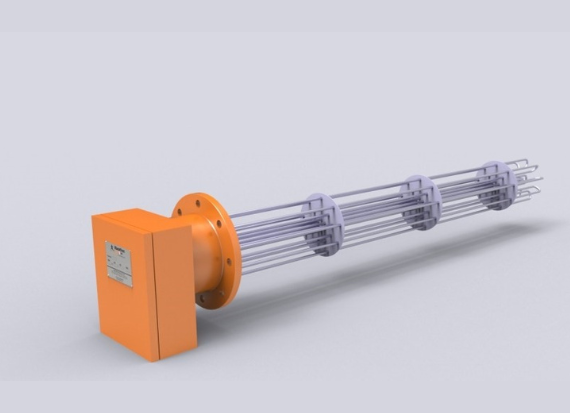Industrial Flanged Heaters Manufacturers in Chennai, India
Welcome to Radiant Heating Technologies, Leading Industrial Flanged Heaters Manufacturers in Chennai, India. Over the past four decades for custom-made flanged immersion heaters specially designed for all industrial heating purpose. RHT flange immersion heaters provides quality, economical and reliable product for large volumes of liquids.
Flange immersion heaters are inserted horizontally into containers, tanks or vessels for direct heating of liquids, allowing the fluid to reach the required temperature.
Our flange immersion heaters come with a host of unique features as follows:
- Effective heat transfer and energy efficiency
- Easy installation and low maintenance
- Custom made heaters at all the sizes
- Specific Wattage /Volts as per the process requirement
- Thermostatic control/RTD provided for precise temperature control
- Low watt density heaters used for longer life
- MOC: MS/SS/Inconel
- Heaters: Removable cartridge type heaters or tubular heater bundles
- Totally sealed weather-proof terminal box
- Applications
- Process air and gas heating
- Process chemical reactors
- Boiler equipment
- Cleaning and rinsing tanks
- Phosphating tanks
- Electroplating
- Lube oil and fuel oil heating
- Hydraulic and heat transfer oils
- Storage tanks
- Caustic solution heating
- Chemical industries
- Water treatment
- Laboratories
- Food processing
To place an enquiry or order for Flanged Heaters Manufacturers in Chennai, please share the following information:
- Number of qty required
- Flange size, rating material
- Element sheath material
- Number of heater elements
- Element watt density
- Hot zone and cold zone lengths
- Type of medium being heated
- Tank or vessel size
- Required temperatures
- Electrical rating – voltage, phase, watts
- Sensing and control type – standard/thermostat type/sensor type and other details
What are Flange Immersion Heater used for?
A Flange Immersion Heater is an electric heater that is immerse directly into a tank or vessel for direct heating of liquids. The flange element is connected to the tank via a flange, which allows it to be easily installed and removed for maintenance or replacement.
What are the applications of Flange Immersion Heaters?
Flange Immersion Heaters are mainly used in industrial and process heating applications, including process air and gas, process chemical reactors, cleaning and rinsing tanks, phosphating tanks, electroplating, lube oil and fuel oil heating, hydraulic and heat transfer oils, storage tanks, caustic solution heating, chemical industries, water treatment, laboratories, and food industries.
What are the advantages of Flange Immersion Heaters?
Flange Immersion Heaters have several advantages, including effective heat transfer and energy saving, easy installation and less maintenance, custom made heaters available in all sizes, wattage as per the process requirement.
What are the factors to consider when selecting a Flange Immersion Heater?
Inputs will vary depend upon the requirements. of medium being heated, the tank or vessel size, the required temperatures, the electrical rating (voltage, phase, watts), the flange size, rating material, element sheath material, the number of heater elements, the element watt density, and the hot zone and cold zone lengths, sensing and control type, such as standard/thermostat type/sensor type, and other details.

